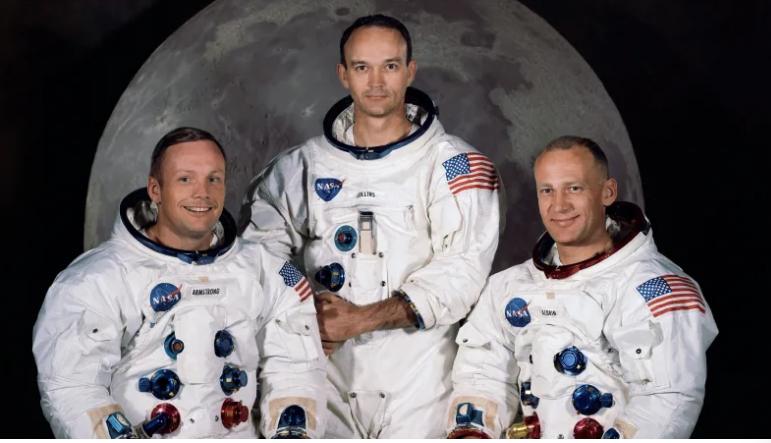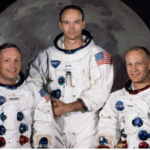Alunizaje del 21 de Julio de 1969. ¿Fue Un Cuento Chino?
Se cumplieron cincuenta años del alunizaje de dos astronautas norteamericanos, Neil Armstrong and Buzz Aldrin mientras un tercero, Michael Collins orbitaba alrededor del satélite terrestre y se ocupaba de poner todo en marcha para que sus compañeros pudieran abandonar esa superficie inhóspita y regresar al Planeta Tierra.
Increíblemente existen aún muchas teorías conspirativas que niegan que ese hecho histórico sea cierto. Las razones son religiosas en algunos casos, en otros simple ignorancia y otras que ni vale la pena explorar.
Es cierto que los “yankees” tienen mucha imaginación. Después de todo crearon Hollywood, la meca del cine, imitada por tantos otros países.
¿Pero no es una locura pensar que más de cuatrocientos mil humanos de distintas nacionalidades, trabajaron en un proyecto secreto para engañar al resto del planeta con una historia apócrifa, y que cincuenta años después ninguno de ellos ha salido a decir la verdad, ni siquiera en su lecho de muerte? Sería demasiado. Al menos en mi opinión.
Les voy a contar algunas razones, aparte de ésa, por las cuales el alunizaje fue un hecho histórico y no un cuento chino.
En total, doce hombres han pisado la superficie lunar. Y si ven los intentos fracasados anteriores al exitoso, es francamente inimaginable que hayan encontrado hombres profesionales, preparados e inteligentes que hayan aceptado esas misiones que parecían estar mucho más cercanas al sacrificio humano que a una exitosa carrera como astronauta.
¿Porque puedo aseverar que no fue todo un fraude? Porque además de la consabida bandera, que plantaron en la superficie en forma de “L” invertida para que siempre este flameando (*), también dejaron otros objetos de manufactura humana allí.
No sólo equipo descartado que no podían volver a llevarse, sino aparatos que han sido usados desde entonces, como el espejo de aterrizaje de Apolo (el Lunar Laser Ranging en inglés). Este mide la distancia entre las superficies de la Tierra y la Luna utilizando rayos láser. Los láseres en los observatorios de la Tierra apuntan a los retro-reflectores colocados en la Luna durante el programa Apolo y las dos misiones Lunokhod.
Cuando cualquier observatorio de la tierra coloca sus poderosos telescopios en la dirección correcta, pueden ver este objeto hecho por el hombre. Es innegable que allí está y no hay otra forma que una visita personal humana para haberlos colocado allí.
Si ni los rusos, los chinos o los indios han salido a desmentir este hecho, podemos quedarnos tranquilos sabiendo que es cierto. Esos países nunca conspirarían para apoyar a sus rivales históricos.
El presidente John F. Kennedy fue quien le dijo a su gente “tenemos que ganarles a los rusos como sea. Tenemos que aterrizar en la luna antes que ellos”. Los rusos habrían salido a desmentirlo de inmediato si no fuese cierto. Se jugaban con ello la supremacía del planeta.
Otro hecho que no es tan conocido es qué pasó con los primeros tres astronautas, los del Apolo 11.
Neil Armstrong, el primer humano en pisar la luna, era Ingeniero aeronáutico, aviador naval, piloto de pruebas y profesor universitario.
Buzz Aldrin Ingeniero y piloto de combate.
Mientras que Michael Collins era piloto de pruebas y general mayor de las Reservas de la Fuerza Aérea de los Estados Unidos
Tanta preparación profesional no los alcanzó en absoluto para lo que les pasó a su regreso a tierra. Se convirtieron de inmediato (después del período de cuarentena) en celebridades a nivel planetario. Nadie había advertido que eso podría pasar. De hecho las apuestas apuntaban a que no regresarían con vida. Sin ir más lejos el presidente Richard Nixon tenía preparado un discurso de condolencia en el caso de que Armstrong y Aldrin quedaran aislados en la superficie de la Luna sin poder ser rescatados.
Esa fama involuntaria los afectó grandemente.
Aldrin dijo que no podía manejar su fama de estrella de cine y después de su regreso luchó contra la depresión y la adicción al alcohol. En la década de 1970, sufrió dos divorcios, perdió su fortuna y terminó trabajando en un concesionario de Cadillac en Beverly Hills. Finalmente se amigó hace pocos años con su estatus de celebridad y participó en shows como The Big Bang Theory y Dancing With the Stars. Hoy está muy presente en las noticias.
Armstrong por su parte sólo asistió a las celebraciones por el 30 aniversario presionado por NASA. Nunca le gustó su fama. Se retiró de la NASA un año después del Apolo 11 y se convirtió en profesor en la Universidad de Cincinnati. Su matrimonio se vino abajo después que se jubiló luego de la muerte de su hija, según su biógrafo. Ni siquiera le gustaba hablar de su paso por la NASA, e incluso se puso furioso cuando un peluquero guardó hebras de su cabello para venderlas por miles de dólares, según informó The Telegraph. Armstrong murió en 2012 a los 82 años.
Michael Collins, sin embargo, sobrevivió no sólo al Apolo 11, sino a la fama, ya que no fue tan conocido como sus dos compañeros. Su matrimonio se mantuvo intacto y trabajó en varios puestos de alto nivel. El realmente no llegó a tocar la luna, pero eso pareció no molestarle en absoluto según aseguró recientemente.
Los científicos creen que las seis banderas estadounidenses plantadas por los astronautas se han blanqueado tras más de 40 años de exposición a la radiación solar.Ellos afirman que cinco de las seis banderas estadounidenses aún están de pie y proyectando sombras en todos los sitios, excepto la del Apolo 11.(*)El astronauta Buzz Aldrin informó que la bandera fue derribada por el escape del motor de ascenso durante el despegue de Apolo hacia fuera de la atmósfera lunar.
Esta nota se la quiero dedicar a uno de los héroes de la exploración espacial, principalmente porque fue a una misión suicida en forma involuntaria.
La nave soviética Sputnik 2, llevaba en su interior a una perrita callejera recogida de las calles de Moscú. La llamaron Kudryavka pero como ladró, más tarde se hizo conocida como Laika, “ladrador” en ruso. Originalmente los rusos mintieron en los informes y dijeron que la perrita, lanzada en un viaje de ida sola en noviembre de 1957, murió sin dolor en órbita aproximadamente una semana después del despegue. Recién en 1993 el médico ruso y entrenador de perros espaciales Oleg Gazenko reveló que después de cinco a siete horas de vuelo, no se recibieron señales de vida de Laika. Para la cuarta órbita, era evidente que Laika había muerto por sobrecalentamiento y estrés. Los ruidos y las presiones del vuelo aterrorizaron a la pobre cachorra: el latido de su corazón se disparó para triplicar la frecuencia normal, y su ritmo de respiración se cuadruplicó. Lo saben porque la habían intervenido quirúrgicamente y le habían insertado medidores en su cuerpo. Llegó a la órbita con vida, rodeando la Tierra en unos 103 minutos. Desafortunadamente, la pérdida del escudo térmico hizo que la temperatura en la cápsula aumentara inesperadamente, afectando fatalmente a Laika. “La temperatura dentro de la nave espacial después de la cuarta órbita registró más de 90 grados centígrados. “Realmente no puede haber llegado más allá de una órbita o dos después de eso. Con su pasajera muerta a bordo, Sputnik 2 continuó en órbita durante cinco meses.El “ataúd” de Laika rodeó la Tierra 2.570 veces y se quemó en la atmósfera de la Tierra el 4 de abril de 1958.
Pero para no terminar en una nota triste, los dejo con un enlace que muestra en un video de 2002, como Buzz Aldrin, uno de los pioneros en pisar la luna y quien hoy tiene 89 años, es confrontado en la calle por un negador del alunizaje. El personaje le dice agresivamente que es un mentiroso y un fraude y lo conmina a “jurar sobre una biblia que todo había sido cierto”. Van y vienen, van y vienen, hasta que el ex astronauta, dá por terminada la discusión de una certera (y bien merecida) trompada. Tenía 72 años y no fue acusado porque la justicia consideró que fue en legítima defensa.
https://www.youtube.com/watch?v=d-FxgdQGLjw
Moon landing on July 21, 1969. Was it a Hoax?
It’s been fifty years since the landing on the moon of two American astronauts, Neil Armstrong and Buzz Aldrin. A third one, Michael Collins, orbited around the Earth’s satellite while making sure that everything was in place so that his teammates could leave that inhospitable surface and return to Planet Earth.
Incredibly, there are still many conspiracy theories that deny that this historical fact is true. The reasons are religious in some cases, in other cases simple ignorance, and yet in others it’s not worth exploring. It is true that the “gringos” have a lot of imagination. After all, they created Hollywood; the mecca of cinema, imitated by so many other countries.
But isn’t it crazy to think that more than four hundred thousand humans of different nationalities worked on a secret project to deceive the rest of the planet with an apocryphal story, and that fifty years later none of them has come out to tell the truth, not even in their deathbed? You must admit that it is “a little bit far fetched”. At least in my opinion.
I am going to tell you some reasons, apart from these, why the moon landing was an historical fact and not a hoax.
In total, twelve men have stepped on the lunar surface. And if you see the failed attempts before the successful one, it is frankly unimaginable that NASA found professional, well prepared and intelligent men who would have accepted those missions that seemed to be much closer to human sacrifice than to a successful career as an astronaut.
Why can I claim that it was not all a fraud? Because in addition to the familiar flag they planted on the surface in the form of an inverted “L” so that it is always waving, they also left other objects of human manufacture there. Not only discarded equipment that could not be taken back, but devices that have been used since then, such as the Lunar Laser Ranging. This measures the distance between the surfaces of the Earth and the Moon using laser beams. Lasers on Earth observatories point to the retro-reflectors placed on the Moon during the Apollo program and the two Lunokhod missions.
When any earth observatory places its powerful telescopes in the right direction, they can see this man-made object. It is undeniable that the objects are there and there is no other way than a human has placed them there. You can be sure that if neither the Russians, the Chinese or the Indians have come out to deny this fact, we can rest easy knowing that the moon landing is true. They would never conspire to support their historical rivals.
President John F. Kennedy was the one who told his people “we have to beat the Russians. We have to land on the moon before them.” The Russians would have come out to deny it immediately if it were not true. The supremacy of the planet was at stake.
Another not so well-known fact is what happened to the first two astronauts who stepped on the moon and their teammate.
Neil Armstrong, the first human to step on the moon was an aeronautical engineer, naval aviator, test pilot and university professor.
Buzz Aldrin was an Engineer and combat pilot. Michael Collins was a test pilot and senior general of the United States Air Force Reserves.
They had so much professional preparation, but nothing prepared them at all for what happened upon their return to Mother Earth.
After the required quarantine period, they became instant celebrities at a planetary level. No one had warned them that this could happen. In fact, the bets indicated that they would not return alive. Without going any further, President Richard Nixon had prepared a sympathy speech in the case that Armstrong and Aldrin were isolated on the surface of the Moon and unable to be rescued. That involuntary fame affected them greatly.
Aldrin said he could not handle his movie star fame and after his return he fought against depression and alcohol addiction. In the 1970s, he suffered two divorces, lost his fortune and ended up working at a Cadillac dealership in Beverly Hills. Finally, a few years ago he made friends with his celebrity status and participated in shows like The Big Bang Theory and Dancing With the Stars.
Armstrong, for his part, only attended the celebrations for the 30th anniversary at the insistence of NASA. He never liked his fame. He retired from NASA a year after Apollo 11 and became a professor at the University of Cincinnati. His marriage fell apart after he retired after the death of his daughter, according to his biographer. He didn’t even like to talk about his time at NASA, and he even got furious when a hairdresser saved strands of his hair to sell them for thousands of dollars, according to The Telegraph. Armstrong died in 2012 at age 82.
Michael Collins, however, survived not only Apollo 11, but fame as he was not as well-known as his two companions. His marriage remained intact and worked in several high-level positions. He didn’t really touch the moon, but that didn’t seem to bother him at all as he recently said.
Scientists believe that the six American flags planted by astronauts have bleached after more than 40 years of exposure to solar radiation. Using LROC images, scientists claim that five of the six American flags are still standing, except that of Apollo 11 Astronaut Buzz Aldrin reported that the flag was blown down by the escape engine’s blast during the takeoff of Apollo out of the lunar atmosphere.
I would like to dedicate this essay to one of the heroes of space exploration, mainly because she went on an involuntary suicide mission.
The Soviet ship Sputnik 2 carried inside a street dog collected from the streets of Moscow. They called her Kudryavka but as she barked, she later became known as Laika, “barker” in Russian.
The Russians originally lied in the reports and said that the animal, launched on a one-way trip in November 1957, died painlessly in orbit about a week after takeoff.
Only in 1993 the Russian doctor and space dog trainer Oleg Gazenko revealed that after five to seven hours of flight, no signs of life were received from Laika. By the fourth orbit, it was evident that Laika had died from overheating and stress. The sounds and pressures of the flight terrified the poor puppy: her heartbeat shot up to triple the normal frequency, and her breathing rate quadrupled. They know this because she had surgery and had all kinds of devices inserted in her body. She reached orbit alive, circling the Earth in about 103 minutes. Unfortunately, the loss of the heat shield caused the temperature in the capsule to rise unexpectedly, affecting Laika. “The temperature inside the spacecraft after the fourth orbit registered more than 90 degrees Celsius” It really can’t have reached beyond an orbit or two after that. With its dead passenger on board, Sputnik 2 continued in orbit for five months.
Laika’s “coffin” surrounded the Earth 2,570 times and burned in the Earth’s atmosphere on April 4, 1958.
Not to end on a sad note, I leave you with a link. It shows a 2002 video, as Buzz Aldrin one of the pioneers in stepping on the moon and who is now 89 years old, is confronted on the street by a denier of the moon landing. The aggressive man tells him that he is a liar and a fraud and urges him to “swear on a bible that everything had been true.”
The exchange lasts for a couple of minutes, until the former astronaut, ends the discussion with a precise (and well deserved) punch to the face. He was 72. He was not charged because it was considered legitimate self defense by the judge.
https://www.youtube.com/watch?v=d-FxgdQGLjw




